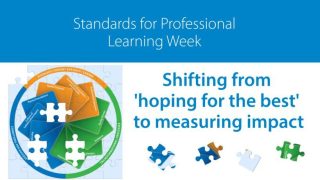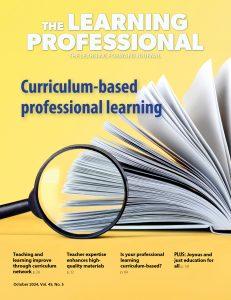Learning Forward recognizes the importance of measuring the impact of professional learning. We are committed to helping professional learning leaders find ways to document success and tie it to teacher excellence and student achievement. The April issue of The Learning Professional explores ways to overcome common challenges when trying to measure how professional learning initiatives improve teacher and student learning.
The subject matter is also personal to me because advocating for multiple measures of success was key to systemwide improvements we made in the California school district I oversaw for many years.
When I became superintendent of the San Mateo Union High School District in 2009, I shared with the board and key stakeholders that an investment in professional learning was key to student achievement — and that we’d have to find ways to measure success at key points along that journey.
Some background: San Mateo is one of the wealthiest districts in the state, but also one with extreme pockets of poverty and diversity. That disparity is not unique in school districts, but it presents challenges in analyzing and implementing new learning programs and measuring their success. You can’t just look at test scores when 25% of your student population is in English language learner programs and traditionally struggle with such measures. You need to find ways to tie the learning done by teachers to growth — growth by teachers and growth by students.
It’s easy to find agreement on this approach until it comes time for implementation, which takes commitment and an application of scarce resources. We needed buy-in for this approach. From the start, I told the board and community that the way we would improve performance was through professional learning for teachers. Not through a new curriculum or a single program, but by helping teachers become really good at their craft.
We used multiple measures in looking at the growth in student achievement. We looked at the more traditional measures of API/AYP scores, SAT scores, AP scores, ELL movement, and student GPAs. We measured and compared student achievement in Algebra 1 and Algebra 2 over the years. We looked at the data around students meeting the University of California A-G subject admission requirements. We watched the enrollment in our continuation high school drop from 250 to less than 150 students because we were finding ways to help students achieve success in their home schools and remain on track for graduation.
The first thing we did was to develop a professional learning structure at the district level and at the sites. That was a challenge because we were spending more money and taking some of our better teachers out of the classroom. Immediately, the call came to measure and show success to justify the change in the allocation of resources. This required a specific approach: making a deep commitment for two to three years of data analysis and assessment and also being willing to evaluate, revise, or shed a program or investment if the results were not encouraging along the way.
We tackled our concerns on multiple fronts, always driven by data that showed where we needed improvement. This affected professional learning in all aspects of the system from increased training for ELL teachers to training teachers in a new math program. One of our most intense efforts in math was to focus on Algebra 2. We discovered, through our analysis, that success in Algebra 2 was the key success standard in college completion.
One crucial learning area for teachers was a new commitment to social-emotional learning to better support low-income students. The administration and teacher groups wondered why we were spending time and money on emotional support. We explained that building relationships with students was another way to improve student achievement. Measuring improvement during implementation gathered support to scale and continue the program.
I saw firsthand how important it was to gather multiple measures of success to get buy-in for professional learning programs. If you show teachers, administrators, the board, and the community results from their investment, then you will have wonderful, strong partners in your learning leadership journey.
This post is adapted from the April 2017 issue of The Learning Professional, Learning Forward’s bimonthly magazine. It also appears in Learning Forward’s PD Watch.





